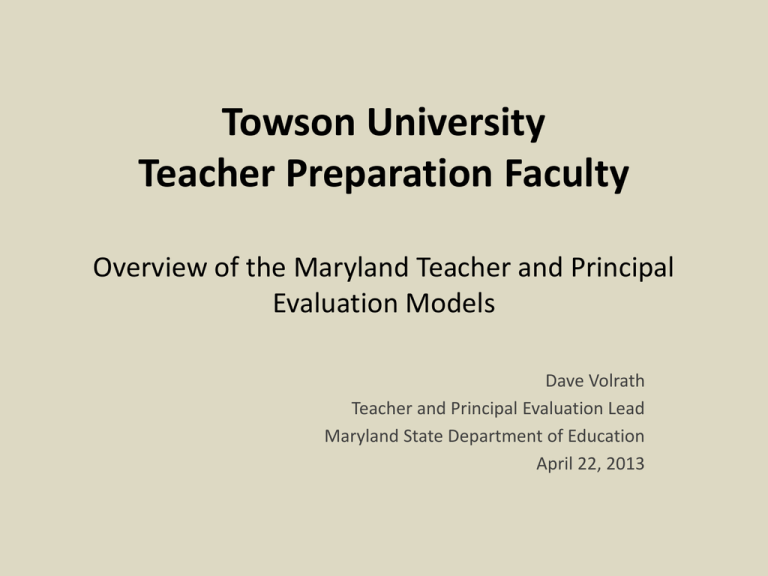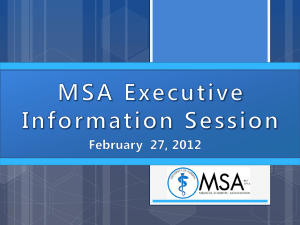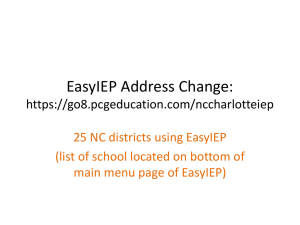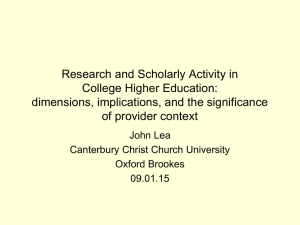Overview of the Maryland Teacher and Principal Evaluation Models
advertisement

Towson University Teacher Preparation Faculty Overview of the Maryland Teacher and Principal Evaluation Models Dave Volrath Teacher and Principal Evaluation Lead Maryland State Department of Education April 22, 2013 Educator Effectiveness and Teacher/Principal Evaluation 2010 Education Reform Act ESEA Flexibility Waiver Race To The Top Participants All LEAs All LEAs 22 LEAs Probationary period extended to three years for tenure with tenure transportable Performance evaluations to include observations, clear standards, rigor, evidence of observed instruction Annual evaluation of tenured and effective or highly effective teachers on a three year evaluation cycle Principle 3 Requires 20% MSA (for attributable) elementary and middle school teacher and principal evaluation Annual evaluation of principals and nontenured or ineffective teachers on yearly cycle Data on Student Growth as a significant component of the evaluation and as one of the multiple measures Principle 3 Requires each high school teacher (in tested areas) and principal to include one Student Learning Objective with a data point on student performance on Statewide high school assessments in the evaluation Agreement on model by LEA and the exclusive employee representative Student growth as progress assessed from a clearly articulated baseline to one or more points in time Principle 3 Requires Ratings of Highly Effective, Effective , and Ineffective in SY 20132014. Model Performance evaluation criteria mutually agreed on by the LEA and the exclusive employee representative Approved evaluation model of local or state design Default to the state model if the local model is not approved or not agreed upon by the exclusive employee representative Professional Practice value of 50% Student growth as progress assessed by multiple measures and not based solely on an existing or newly created single exam or assessment Student Growth value of 50% Existing or newly created assessments may be used as one of the multiple measures Results reported Rating of teachers and principals according to Highly Effective, Effective, or Ineffective Appeal process provided No single criteria shall account for more than 35% of the total performance criteria Other Items •Attribution: Associating students enrolled on 9/30, still enrolled on the day of testing, and present 80% of the instructional days to the teacher of record •Teacher of Record: The teacher(s) most directly responsible for the delivery of the instruction to the student •Evaluation Cycle: Tenured and Effective or Highly Effective Educators = Student Growth annually and Professional Practice every three years Untenured and Ineffective Educators = Student Growth annually and Professional Practice annually •Professional Practice Teacher: Four Domains; Planning & Preparation, Instruction, Classroom Environment, Professional Responsibilities •Professional Practice Principals: Eight Maryland Instructional Leadership Framework Domains, and Four ISLLC Domains •School Progress Index: Annual whole-school accountability measure of school performance than can be used in teacher and principal evaluation •Student Learning Objectives: Measures of student growth associated with cohorts of students and generated by teacher and principal interests •Teacher & Principal Ratings: Determinations of Highly Effective, Effective, or Ineffective as required in COMAR 13A.07.09 All LEAs 2010 Education Reform Act Probationary period extended to three years for tenure with tenure transportable Performance evaluations to include observations, clear standards, rigor, evidence of observed instruction Model Performance evaluation criteria mutually agreed on by the LEA and the exclusive employee representative Data on Student Growth as a significant component of the evaluation and as one of the multiple measures Student growth as progress assessed from a clearly articulated baseline to one or more points in time Student growth as progress assessed by multiple measures and not based solely on an existing or newly created single exam or assessment Existing or newly created assessments may be used as one of the multiple measures No single criteria shall account for more than 35% of the total performance criteria All LEAs ESEA Flexibility Waiver Principle 3 Requires 20% MSA (for attributable) elementary and middle school teacher and principal evaluation Principle 3 Requires each high school teacher (in tested areas) and principal to include one Student Learning Objective with a data point on student performance on Statewide high school assessments in the evaluation Principle 3 Requires Ratings of Highly Effective, Effective , and Ineffective in SY 2013-2014. 22 LEAs Race To The Top Participants Annual evaluation of tenured and effective or highly effective teachers on a three year evaluation cycle Annual evaluation of principals and non-tenured or ineffective teachers on yearly cycle Approved evaluation model of local or state design Agreement on model by LEA and the exclusive employee representative Default to the state model if the local model is not approved or not agreed upon by the exclusive employee representative Professional Practice value of 50% Student Growth value of 50% Rating of teachers and principals according to Highly Effective, Effective, or Ineffective Appeal process provided Results reported Other Items •Attribution: Associating students enrolled on 9/30, still enrolled on the day of testing, and present 80% of the instructional days to the teacher of record •Teacher of Record: The teacher(s) most directly responsible for the delivery of the instruction to the student •Evaluation Cycle: •Tenured and Effective or Highly Effective Educators = Student Growth annually and Professional Practice every three years •Untenured and Ineffective Educators = Student Growth annually and Professional Practice annually •Professional Practice Teacher: Four Domains; Planning & Preparation, Instruction, Classroom Environment, Professional Responsibilities •Professional Practice Principals: Eight Maryland Instructional Leadership Framework Domains, and Four ISLLC Domains •School Progress Index: Annual whole-school accountability measure of school performance than can be used in teacher and principal evaluation •Student Learning Objectives: Measures of student growth associated with cohorts of students and generated by teacher and principal interests •Teacher & Principal Ratings: Determinations of Highly Effective, Effective, or Ineffective as required in COMAR 13A.07.09 State Teacher Evaluation Model Planning and Preparation 12.5 % Professional Practice Student Growth 50 % Qualitative Measures 4 Domains Each 12.5% 50% Quantitative Measures As defined below Instruction 12.5 % Elementary/Middle School Teacher Two Content Areas • 10% - Reading MSA (Class) and • 10% - Math MSA (Class) and • 10% - School Performance Index and • 20% - Student Learning Objectives or Classroom Environment 12.5 % Professional Responsibilities 12.5 % Elementary/Middle School Teacher or One Content Area English/Language Arts Teachers: • 20% - Reading MSA (Class) and • 10% - School Performance Index and Elementary/Middle School Teacher Non-Tested Subject • 15% - School Performance Index and • 35% - Student Learning Objectives or High School Teacher • 15% - School Performance Index and • 35% - Student Learning Objectives • 20% - Student Learning Objectives Mathematics Teachers: • 20% - Math MSA (Class) and • 10% - School Performance Index and • 20% - Student Learning Objectives 9/27/12 State Principal Evaluation Model • • • • • • • • Professional Practice Student Growth 50% Qualitative Measures 12 Domains Each 2-10% 50% Quantitative Measures As defined below Maryland Instructional Leadership Framework (8) School Vision School Culture Curriculum, Instruction, and Assessment Observation/Evaluation of Teachers Integration of Appropriate Assessments Use of Technology and Data Professional Development • • • • Interstate School Leaders and Licensure Consortium (4) School Operations and Budget Effective Communication Influencing the School Community Integrity, Fairness, and Ethics Stakeholder Engagement Elementary/Middle School Principals or High School Principals or Other Principals (e.g., Special Center, PreK-2) •10% - Reading MSA (School) and • 10% - Math MSA (School) and • 10% - School Performance Index •15% - School Performance Index and •35% - Student Learning Objectives •15% - School Performance Index and •35% - Student Learning Objectives and •20% - Student Learning Objectives 9/27/12 # Revised 9/17/2012: Submitted to USDE for Approval Maryland School #Progress Index Grades PreK-8 Meeting Performance Targets (AMO) Achievement* Grades 9-12 30% • 33.3%- Mathematics Proficiency (MSA) • 33.3%- Reading Proficiency (MSA) • 33.3%- Science Proficiency (MSA) Gap* 40% Gap between lowest subgroup and highest subgroup within a school: • 33.3%- Mathematics Proficiency (MSA) • 33.3%- Reading Proficiency (MSA) • 33.3%- Science Proficiency (MSA) Growth* *ALT-MSA is included in the index component 40% Achievement* • 33.3%- Mathematics Proficiency (Algebra/ Data Analysis HSA) • 33.3%- English Proficiency (English HSA) • 33.3%- Science Proficiency (Biology HSA) 40% Gap* Gap between lowest subgroup and highest subgroup within a school: • 20%- Mathematics Proficiency (Algebra/ Data Analysis HSA) • 20%- English Proficiency (English HSA) • 20%- Science Proficiency (Biology HSA) • 20%- Cohort Graduation Rate • 20%- Cohort Dropout Rate 30% Percent of students making one year’s growth: • 50%- Mathematics Proficiency (MSA) • 50%- Reading Proficiency (MSA) Meeting Performance Targets (AMO) #College-and Career-Readiness* 20% • 60%- Cohort Graduation rate • 40%- College and Career Preparation (CCP) • Advanced Placement • Career and Technology Education (CTE) Concentrators • College Enrollment Local Teacher Evaluation Models Professional Practice Student Growth 50 % Qualitative Measures Domain percentages proposed by LEA and approved by MSDE 50 % Quantitative Measures As defined below Planning and Preparation Instruction Classroom Environment Professional Responsibilities Additional Domains Based on Local Priorities Elementary/Middle School Teacher Two Content Areas • 10 % - Reading MSA (Class) and • 10 % - Math MSA (Class) and • 30% - LEA proposed objective measures of student growth and learning linked to state and/or local goals and approved by MSDE or Elementary/Middle School Teacher or One Content Area English/Language Arts Teachers: • 20% - Reading MSA (Class) and • 30% - LEA proposed objective measures of student growth and learning linked to state and/or local goals and approved by MSDE Elementary/Middle School Teacher or Non-Tested Subject LEA proposed objective measures of student growth and learning linked to state and/or local goals and approved by MSDE; no single measure to exceed 35% High School Teacher LEA proposed objective measures of student growth and learning linked to state and/or local goals and approved by MSDE; no single measure to exceed 35% Mathematics Teachers: •20% - Math MSA (Class) and • 30% - LEA proposed objective measures of student growth and learning linked to state and/or local goals and approved by MSDE 9/27/12 Local Principal Evaluation Models Professional Practice Student Growth 50 % Qualitative Measures Domain percentages proposed by LEA and approved by MSDE 50 % Quantitative Measures As defined below • • • • • • • • Maryland Instructional Leadership Framework (8) School Vision School Culture Curriculum, Instruction, and Assessment Observation/Evaluation of Teachers Integration of Appropriate Assessments Use of Technology and Data Professional Development Stakeholder Engagement Elementary/Middle School Principals • 10 % - Reading MSA (School) and • 10 % - Math MSA (School) and • 30% - LEA proposed objective measures of student growth and learning linked to state and/or local goals and approved by MSDE or Additional Domains Based on Local Priorities High School Principals LEA proposed objective measures of student growth and learning linked to state and/or local goals and approved by MSDE; no single measure to exceed 35% or Other Principals (e.g., Special Center, PreK-2) LEA proposed objective measures of student growth and learning linked to state and/or local goals and approved by MSDE; no single measure to exceed 35% 9/27/12 Teacher Evaluation Professional Practice ___________ Classroom Environment 50% Instruction Teacher Controlled Elements State Test Measures Planning & Preparation Student Learning Objectives 30% MSA/PARCC 20% Tested Area Teacher Example Maryland Tiered Achievement Index: Field Test Version A CCPS approach to using the Standard Deviation to interpret performance Performance spanning the grade mean by one standard deviation is considered expected and acceptable (green bracket). Growth more than .5 STD above mean is beyond expected and commendable (blue bracket). Performance .5 STD below the central range is concerning (yellow bracket); performance a full STD below mean is a significant loss and unacceptable (red bracket). Slide borrowed from CCPS presentation, March 11, 2013 A real example Maryland Tiered Achievement Index: Considered Version for Go-Live Year •Expands the premium “blue area” by one diagonal. •Expands the diagonal, protecting cells A3A1, P3P2, P2P1, and mitigating A1P3. •Reflects the actual state distribution and is informed by the MSA underlying technical structure Local Model Teacher Evaluation & Professional Development Cycle ____________________ Professional 80% Practice E v a l u a t i o n MSA/PARCC 20% Tested Area Teacher Example Individual Professional Development Plan Professional Practice 50% Classroom Environment Instruction Planning & Preparation 30% Student Learning Objectives Teacher Controlled Elements MSDE had to model… •Teacher Instrument •Principal Instrument •Instrument Appendices •Calculation Methodology •Administrator Impact •Three Year Rollout …see exhibits on msde/tpe website SIP HSA Results MSA Evaluation Results Summer HSAs Fall Spring AP Winter MSAs Current Models AP Results Pre-Conference Data Analysis •Translate MSA to % •Set SLOs •Review Annual Data •Align SIP Goals •Write SIP SIP HSA Results MSA Results Summer HSAs AP Spring Fall AP Results Evaluation Winter •Score SLOs •Score Professional Practice •Carry forward MSA % •Complete Rating •Affirm Attribution •Set new Professional Practice Goals MSAs New evaluation paradigm Professional Practice •Conduct Observations •Mid-Interval SLO Check TPE Action Team Structure Communication Team Laura Motel Professional Development Team TPE Action Team Dave Volrath Linda Burgee (non SLO) Ilene Swirnow Ilene Swirnow Laura Motel Ben Feldman Psychometrician SLO Team Linda Burgee Field Test Team Ben Feldman Communications Project Status: April 22, 2013 •Completed Field Testing in all LEAs •Gathered Qualitative Data •Established Fidelity Assurance……. 1. What Characteristics were associated with higher degrees of implementations readiness • TPE Committee: Stakeholders & regular meetings • Built on existing Systems: Scaffold participants into new elements • Training on components of new TPE: Field test & non-field test participants • Focus on the opportunities the TPE process offers to improve instructional practice and student learning • Clear communication plans: Emphasis on common and consistent messages • Data systems: Central office, School, and Classroom… Collection, Analysis, Retrieval, and Retrieval • Collaboration with other LEAs 2. What variables impacted an LEA’s readiness to implement TPE • LEA size, access to funding, and central office capacity • Degree to which the LEA is developing and/or implementing a new TPE system…alignment with previous versions • Role played by local bargaining units • Existence of local common assessments • LEA preparation during 2011-2012 • Central office and school administrator turnover 3. What issues continue to impact an LEA’s readiness to implement TPE • • • • Timing of student assessment results with the calendar 20% application of MSA to tested areas Systems require significantly more time SLOs: need to see additional models and exemplars from different grade and content levels • Conflict between the Common Core curriculum and existing student measures. • Benefit of more no fault time to prepare …continued • Determining Quantitative Data • Defining Field Test and Project Analysis with WestEd • Preparing for Implementation • Resource Realignment Communication Team Laura Motel Leadership Development Team Ilene Swirnow TPE Action Team Field Test Team Dave Volrath Ben Feldman SLO Team Linda Burgee Readiness Next Steps… •Field Test Lessons Learned •Rating Standard Setting •PD for Principals, Executive Officers, & Evaluators •System Readiness •Teacher Readiness & Preparation Student Learning Objectives MSA/PARCC Common Core Standards Teacher Evaluation Professional Growth Contact Dave Volrath dvolrath@msde.state.md.us 410 767 0504 or MarylandPublicSchools.org/MSDE/programs/TPE











